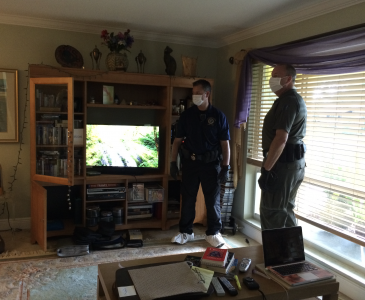NSU Newsroom
SharkBytes
Horizons
This version of NSU News has been archived as of February 28, 2019. To search through archived articles, visit nova.edu/search. To access the new version of NSU News, visit news.nova.edu.
This version of SharkBytes has been archived as of February 28, 2019. To search through archived articles, visit nova.edu/search. To access the new version of SharkBytes, visit sharkbytes.nova.edu.
NSU Research Spotlight: Researchers Show Human Microbiome Could Help in Solving Crime
Look out would-be thieves and criminals, there’s another tool that could soon be in the law enforcement investigator’s toolbox. Researchers have discovered that every individual’s microbial community (or “microbiome”) found on their body is as unique as human fingerprints or DNA, and this bacterial signature can be left behind even if the aforementioned forensic markers are not.
Jose Lopez, Ph.D., a professor at Nova Southeastern University’s (NSU) Halmos College of Natural Sciences and Oceanography worked with colleagues from the University of Illinois at Chicago and the University of Chicago as part of The Burglary Microbiome Project. The project was funded by the National Institute of Justice.
“We all have bacteria living on us, no matter how much we wash our skin,” Lopez said. “And most of the microbes are harmless and even can stop bad bacteria from colonizing. Everyone’s microbiome is different; we slough off millions of microbial cells every hour into our surroundings (su rfaces and air), so we’re leaving our microbial signature wherever we go.”
rfaces and air), so we’re leaving our microbial signature wherever we go.”
Joining Lopez on this project were Jack Gilbert, Ph.D., the faculty director of The Microbiome Center at the University of Chicago (lead primary investigator), Jarrad Hampton-Marcell, a Ph.D. candidate at the University of Illinois at Chicago and George Duncan, Ph.D., an adjunct professor in NSU’s Department of Justice and Human Services and Halmos College.
The approach to the study was relatively simple: the researches took samples from people’s noses and hands and then various surfaces from their homes to create their baseline microbiome. Then they conducted mock burglaries by people who would not otherwise be in those homes. Using the “bacterial assemblages” for each subject, models were created to determine the accuracy of predicting a non-resident being in a given home. In other words, they compared the known microbiome with evidence of foreign microbiome traces in the homes. The idea is having this information, if the authorities apprehend a suspect, they can compare their microbiome to the foreign one from the crime scene.
According to researchers, humans emit approximately 36 million microbial cells every hour into their immediate environment. This gives researchers the chance to trace these signatures back to their originating source. It had already been established that it was possible to track the microbial exchange between an individual and environmental surfaces by matching the microbial signature on individual participants’ finger tips to keys on a computer keyboard, as well as other personal devices.
While there is still more research to be done, the initial results are very promising.
“This study is one of the first to use the microbiome as a forensic tool using unique markers rather than variances in microbial community structure,” said Hampton-Marcell, “With further improvement in detection of stable markers, the human microbiome may serve as an additional tool for human profiling and crime scene investigations.”

